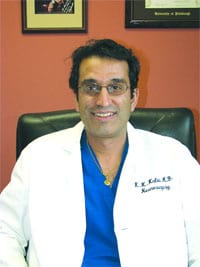‘It Sounds Like Science Fiction’ UMass Researcher Wants to Turn Bacteria into Cancer-fighting Robots
Neil Forbes, an assistant professor of Chemical Engineering at UMass Amherst, has received a four-year grant of more than $1 million from the National Institutes of Health to research the possibility of killing cancer tumors with salmonella bacteria.
Forbes aims to turn the bacteria into tiny terminator robots that use their own flagella to venture deep into tumors where conventional chemotherapy can’t reach. Once in place, the bacteria manufacture drugs that trigger cancer cells to kill themselves.
“When we get the salmonella bacteria into the part of the tumor where we want them to be, we’ve programmed them to go ape,” Forbes said. “We have the bacteria release a drug to trigger a receptor in cancer cells called the ‘death receptor,’ which induces cancer cells to kill themselves. We’ve already done this in the lab. We’ve done this successfully in cancerous mice, and it dramatically increases their survival rate.”
Normally, mice with tumors all die within 30 days. After receiving this bacterial system and getting a dose of radiation, all the mice in Forbes’ lab tests survived beyond the 30 days, which could potentially translate into many months or years in people.
“It sounds like science fiction, doesn’t it?” Forbes said. “But salmonella are little robots that can swim wherever they want. They have propellers in the form of flagella, they have sensors to tell them where they are going and they are also little chemical factories. What we do as engineers is to control where they go, what chemical we want them to make, and when they make it.”
Using bacteria to attack cancer tumors has been tried with only moderate success for decades. But Forbes’ work with salmonella is introducing a radical improvement called ‘targeted intratumoral therapeutic delivery,’ which sends the bacteria into parts of the tumor that are currently beyond the reach of conventional therapies. This could translate into individualized doses of chemotherapy for human cancer patients, make therapy more specific and effective, give people smaller doses of chemicals while they are being treated, and cut down on patient mortality.
Limited Access
The basic problem being addressed by Forbes is that some regions in any cancer tumor are impossible to reach with current chemotherapy drugs. Drug access to the tissue in any tumor is limited by the distribution of its blood vessels. Tissue located farthest from its surrounding blood vessels is the hardest for drugs to reach because the vessels act as their chemical highways into the tumor. Every tumor has a different distribution of blood vessels, depending on the nature of the tumor and the patient’s genetic makeup.
“Think of the region between blood vessels as a sponge,” Forbes explained. “The particles from a therapeutic drug tend to accumulate around the outer portions of the sponge, nearest the blood vessels, and not penetrate to the interior.”
That’s where an unlikely hero, the salmonella bacterium, comes in. Unlike drugs, which are not alive, salmonella can take energy from their environment and can ‘swim’ wherever they please. They have their own outboard motors called flagella, and can travel where they want in a tumor, regardless of blood vessels. Forbes’ concept is to use special salmonella disarmed of their toxicity and fix them with drug payloads so they can swim into these hard-to-reach regions of the tumor and kill the cancer cells there.
“The bacteria, as far as I can tell, are the only therapy that can penetrate deep into tissue, far beyond where blood vessels reach,” says Forbes.
Bacteria naturally seek out dead tissue for food by using sensors that home in on chemicals such as ribose, given off by dying cells. But Forbes doesn’t want his salmonella robots going to the dead cancer cells already killed off by chemotherapy. He wants them penetrating to the slow-growing, but live, cancer cells that current therapy can’t touch. So his solution is to remove the ribose sensor from salmonella.
“By knocking out the ribose receptor,” Forbes said, “we can keep the bacteria away from dead cells, where we don’t need them to go, but get them to travel into slow-growing cells located in hard-to-reach tissue far from blood vessels, the regions currently beyond our therapeutic treatment.”
This article was prepared by the UMass Amherst News Office.

